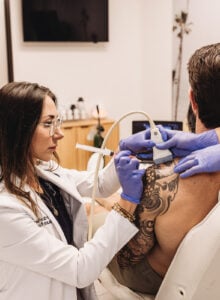Neurofeedback, also known as EEG Biofeedback, is a learning modality designed to retrain dysregulated brainwave patterns. In doing so, the brain becomes more stable and is able to operate optimally and efficiently. It is completely noninvasive and is considered by the Food and Drug Administration (FDA) to be safe. In fact, the FDA recognizes that neurofeedback has NEVER produced a serious side effect since it was first discovered over 60 years ago.
Peer reviewed, published research has demonstrated Neurofeedback Therapy’s efficacy in managing many neurological conditions such as ADHD, Migraine and Tension Headache, Insomnia, Chronic Pain, Post Stroke Syndrome, Anxiety and Panic Attacks as well as many others.
In summary, neurofeedback is guided exercise for the brain.
All neurofeedback begins with a Quantitative Electroencephalogram (QEEG) evaluation. The QEEG is an assessment tool designed to objectively and scientifically evaluate a person’s brainwave patterns.
The procedure consists of placing a snug cap on the head. Embedded within the cap are 12 small sensors that are designed to measure and record electrical activity (or brainwaves) coming from the brain. It is important to note that these sensors do not put any electrical current into the brain – they simply record signals coming from the brain. This recorded brainwave data is statistically compared to a large, sophisticated, normative database and an individualized report is generated. This report allows the medical provider to determine, in a scientifically objective manner, whether a client’s brainwave patterns are different from normal.
The QEEG assessment then provides the data necessary to determine the neurofeedback training protocols that will be used during the training sessions.
These protocols are designed to retrain the brainwave patterns toward normalization. As the brainwave patterns normalize, the brain is able to operate more optimally and efficiently.
Individuals are connected to a computer using wires and sensors, and the computer records their brainwave activity. These sensors are noninvasive, as no electrical current is put into the brain. The sensors simply record the brain waves coming from the brain. Information about these brain waves is displayed on the provider’s monitor. The software automatically detects when the brainwaves are properly ordered and it feeds that information back to the patient. This feedback appears in the form of a game, movie, or sound, which signals the patient that the brainwaves are becoming more ordered.
For example, the patient is watching a puzzle of a picture that is being filled in piece by piece. As long as the patient’s brain waves are moving in an orderly direction, the puzzle pieces are filled in and the patient hears a tone. If the brainwave patterns move away from an orderly pattern, then the puzzle does not get filled in and no tone is produced.
The patient is actually controlling the completion of the puzzle with their brain and by doing so; the brain is learning how to regulate itself.
For the past 60 years neurofeedback has been studied in research labs at prominent Universities throughout the world. In fact, Dr. Frank H. Duffy, a Professor and Pediatric Neurologist at Harvard Medical School, stated.
“Neurofeedback should play a major therapeutic role in many difficult areas. In my opinion, if any medication had demonstrated such a wide spectrum of efficacy it would be universally accepted and widely used.” – Dr. Frank H. Duffy, a Professor and Pediatric Neurologist at Harvard Medical School.
Brainwave dysregulation is a complex problem. Complex problems require complex solutions – there is no simplistic solution to addressing dysregulated brainwave patterns. Coming up with a solution to a complex problem is not linear. Like a Rubik’s Cube, you need to turn some squares forward and some squares backward, and then reverse again, toward the direction you were going in before – but always moving toward an overall positive organization of the structure.
It is not at all unusual for the brain to compensate heavily, at times, in order for it to heal and integrate.
The brain goes through several iterations, where direct change towards normalization progressively increases, however, it may be many sessions beyond symptom improvement before that occurs.
Taina Danahy
Contributed by: Our Partner, Taina Danahy, Co-founder, BTSD and Healing Our Heroes.
Healing Our Heroes helps our service men & women better their quality of life through cost-free Neurofeedback Therapy and works to reduce the 22 a day suicide statistic.
Contact:
email: taina@braintrainsandiego.com
phone: 858.356.4325
DONATE








